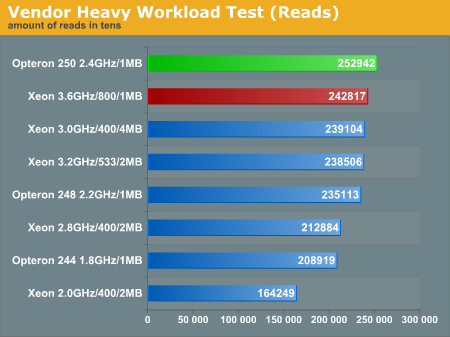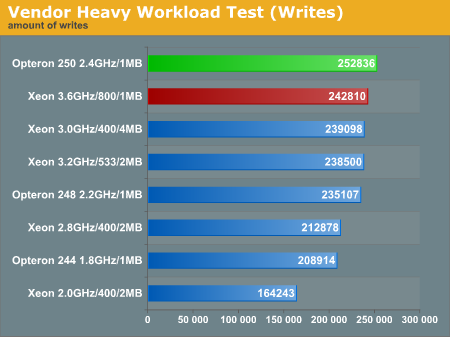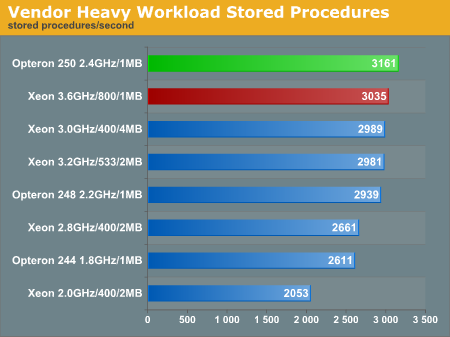Intel Xeon 3.6 (Nocona) vs. AMD Opteron 250 - Database Test
by Jason Clark & Ross Whitehead on September 13, 2004 12:05 AM EST- Posted in
- IT Computing
Order Entry Stress Test Results
Here is where the architectural differences of the Opteron and Nocona are highlighted. The Opteron 250 managed a 7% gain in performance over the 248, impressive scaling for approximately an 8% clock speed increase. The Nocona story doesn't read as well here as the small-medium work load tests, as saturated bus due to the shared FSB implementation of the Xeon is written all over the enterprise test results. If you look at the 3.2 Prestonia results, the 3.6 Nocona only barely managed a 1% gain in performance, which is really within our deviation between runs. The longer pipeline of the Prescott core, combined with a saturated bus, is not helping the Nocona when the going gets tough. Of course, the Nocona is suffering from 1MB less of L2 Cache than the Prestonia Xeon. It's hard to say how much of a difference that makes at this point.

To give you an idea of the scale of this benchmark, we have graphs of stored procedures calls per second. We decided to focus on Stored Procedures/Second rather than Transactions/Second, since the definition of a Transaction can have a business context or a technical context.











44 Comments
View All Comments
appu - Monday, September 13, 2004 - link
#10, I agree with you. I think before doing an AMD vs. Intel shootout a Prestonia vs. Nocona was more in order.Marlin1975 - Monday, September 13, 2004 - link
Another thing I did not see, maybe missed it?, was the 3.6Ghz P4/Xeon is MORE a paper launch then anything as I can't seem to find it anywhere. The higgest Xeon I see in real quanity is the 3.4Ghz.So is it fair to compare a almost impossiable and even higher priced CPU to one that is easy to find and cheaper?
vmajor - Monday, September 13, 2004 - link
Ah, so AMD farted out the specs?"When AMD first broke wind with the K8 announcement.."
That's one way to grab attention...
Victor
Jalf - Monday, September 13, 2004 - link
#8: Well, why should they? It looks like even Intel are starting to realize that performance doesn't equal MHz. They have much easier and more effective ways to improve their performance than to strive for 4GHzgherald - Monday, September 13, 2004 - link
Well well well... a couple of inconclusive 32bit benchmarks.What this article shows that we didn't already know or didn't expect:
- Nothing.
What this article shows that we already knew:
- The Xeon shared FSB is a significant limiting factor.
What this article shows that we did expect:
- The Nocona performs similarly to the Opteron 250 in 32bits.
What this article did not cover:
- 64BIT BENCHMARKS !
- 64BIT vs. 32BIT !
- How do 2xNocona and 2xPrestonia compare at EQUAL clockspeeds? (i.e. exactly how does the decreased cache and longer pipeline affect numbers)
- How does a 1xNocona compare to an equally clocked Prescott and Northwood? (i.e is it just about equal to the Prescott, as one might expect?)
What this article neglected to mention:
- How did the Nocona's use of DDR2 affect the benchmarks, if at all?
- More importantly, how does it affect price vs. performance ? DDR2 is still twice as expensive and offers virtually no performance improvement, right? So assuming the 3.6 Nocona sells at a similar price to the Opteron 250, you still have to factor in the increased memory costs and when packing in 4GB, as with these test systems, it is no mean consideration!
To #9: AMD is in no hurry to do this, what with DDR2 costing twice as much and offering no tangible benefits as of yet.
fergiboy - Monday, September 13, 2004 - link
It is interesting to note that the Intel platform runs on DDR2. AMD is going to have to tweak its processor to release DDR2 support due to the on die memory controller.sprockkets - Monday, September 13, 2004 - link
There will be versions of Prescott that will have more cache. The question is, will it ever reach 4.0ghz without melt down hahaha.hirschma - Monday, September 13, 2004 - link
I'm not sure how cache effects database performance - I'd guess not very much, but I honestly don't know. If my guess is right, AMD is on track to scale right by Intel very shortly.Denial - Monday, September 13, 2004 - link
Nice article Jason, and please keep the server based benchmarks coming. It's refreshing to see numbers from a reputable source, and though the actual results here may not influence many purchases, it at least gets the "Opteron is a viable option" point across.The slight difference between the top of the line Opteron and Xeon is so slim that the choice of a platform would obviously come down to other more relevant factors. The scores are also so close that it if another application were used the Xeon could come out ahead.
The only real way to know if there is any meaningful performance difference between Xeon and Opteron systems would be to benchmark the application you will be using on systems from your vendors of choice. If the difference is less than 10%, more than likely the TCO, support, organizational standards, and more often than not a good sales team will drive the choice of which systems will be purchased. Unfortunately for AnandTech, they'd have to test the systems as they come from the manufacturers, storage and all, for the benchmarks to be useful to a large organization. There can be a very noticeable difference in performance from an HP, IBM and SUN server all using the same processor.
The interesting data will come when we have 64 bit benchmarks using these CPU's. Win64 with 8-32GB of RAM and 64 bit versions of MS SQL, DB2, Oracle, etc., will be much more informative and useful.
DrMrLordX - Monday, September 13, 2004 - link
Might be nice, knightcrow. I haven't seen those used in many(if any) hardware benchmark reviews, though. At least they made mention of the 2% deviation they got with benchmark results.I don't think anybody's really surprised here. I would, however, like to hear from AMDjihad. He's ever-so-insightful.